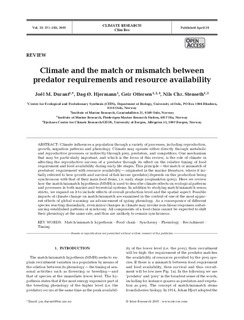| dc.description.abstract | Climate influences a population through a variety of processes, including reproduction, growth, migration patterns and phenology. Climate may operate either directly through metabolic and reproductive processes or indirectly through prey, predators, and competitors. One mechanism that may be particularly important, and which is the focus of this review, is the role of climate in affecting the reproductive success of a predator through its effect on the relative timing of food requirement and food availability during early life stages. This principle—the match or mismatch of predators’ requirement with resource availability—originated in the marine literature, where it initially referred to how growth and survival of fish larvae (predator) depends on this production being synchronous with that of their main food items, i.e. early stage zooplankton (prey). Here we review how the match/mismatch hypothesis (MMH) is used to describe climate effects on ecological patterns and processes in both marine and terrestrial systems. In addition to studying match/mismatch sensu stricto, we expand on it to include effects of overall production level and the spatial aspect. Possible impacts of climate change on match/mismatch are examined in the context of one of the most apparent effects of global warming: an advancement of spring phenology. As a consequence of different species reacting dissimilarly, even minor changes in climate may invoke non-linear responses unbalancing established patterns of synchrony. All components of a food chain cannot be expected to shift their phenology at the same rate, and thus are unlikely to remain synchronous. | en |
